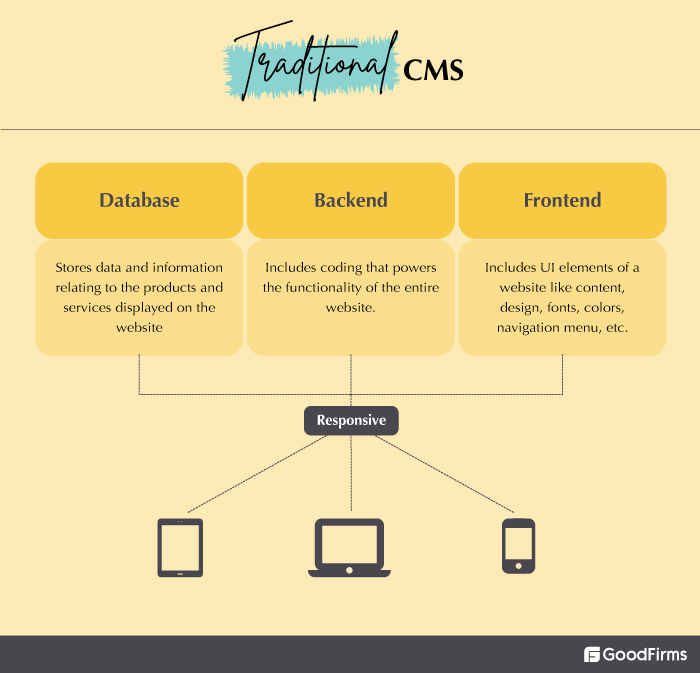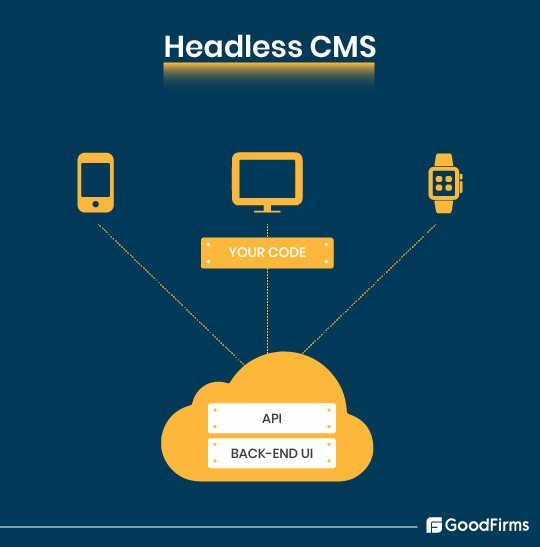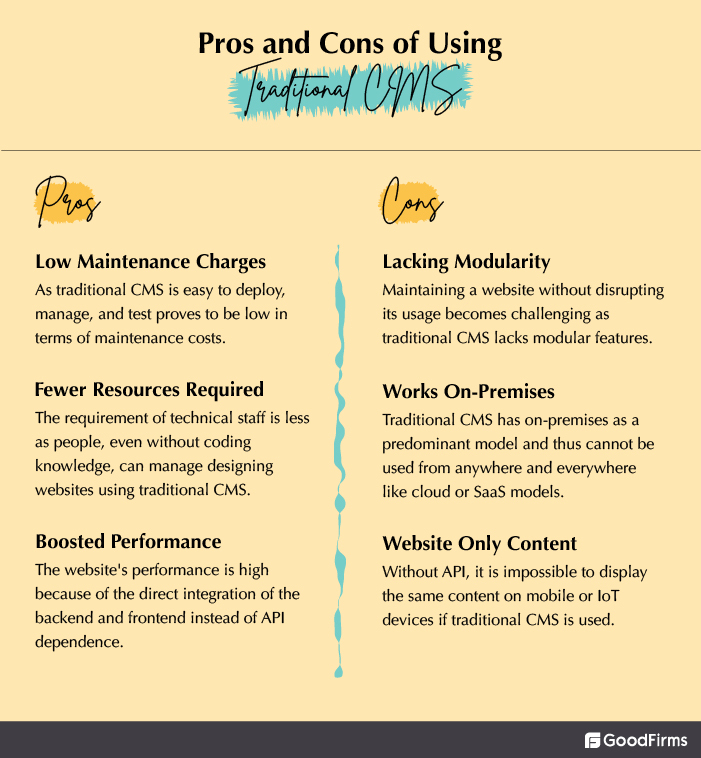Systematically managing and regularly updating information on websites has become critical for the businesses in this competitive and digitally transformed world. Businesses need to keep their website visitors engaged by updating the trending information consistently, and this is where the use of a competent content management software proves to be useful. In case of static websites, the businesses either need to hire a technical team or depend on their web design partners for updating even the minor content changes on their website. On the other hand, a content management system (CMS) allows individuals to easily update information on the websites without possessing technical skills or coding knowledge.
The Role of CMS
As websites transformed from static to dynamic features with interactive content, updating fresh content on a real-time basis and managing content effectively became the top priority for businesses. The demand for CMS-based websites allowing people with non-technical backgrounds to update their content easily increased. For example, marketing professionals can update the latest promotional offer on the website with the help of an intuitive CMS interface, even if they don't have any technical knowledge or coding skills. Thus, the role of CMS-based websites became important within businesses as they provided the capability to multiple users with different job profiles and permission levels to manage the content of a website or a specific section of a website.
It is no surprise that WordPress, one of the most popular traditional CMS, is powering 43% of websites on the internet. However, the term "Headless CMS" has been gaining significant momentum over the past couple of years.
So, what is a headless CMS? How is it getting ahead of traditional content management systems in terms of revolutionizing the user experience across current and future devices and digital platforms?
This article elaborates on everything you need to know about headless and traditional CMS, how they work, their pros and cons, and a detailed comparison of both the systems, helping you determine the best fit for your business needs.
What is Traditional CMS? (Backend + Frontend)
Traditional CMS, also known as a monolith, is a type of content management system with integrated frontend and backend systems so that even non-technical professionals can add, modify, edit, and change the content on the website. The front end of the traditional CMS consists of HTML templates, Javascript, and CSS, whereas its back end includes code & plugins, web architecture, and a database.
How Does Traditional CMS Work?

Using traditional CMS, the content cannot be stored in modules, making it difficult for you to reformat or reuse it for other platforms besides the Web. It also becomes highly complex to add functionality and features without a plugin or integration.
Earlier, traditional CMS was prevalent for developing websites, but now companies are looking for improved scalability and increased flexibility in getting the same content displayed over multiple platforms and devices, which only headless CMS solutions can provide. Let's know more about headless CMS here.
What is a Headless CMS? (Backend + API)
What is API?
Application Programming Interface, abbreviated as API, is a set of protocols that connects two software and applications.
A headless CMS is an advanced content management system that includes a backend and no frontend (head), and so it is called "headless." The backend of headless CMS makes the content available through RESTful API or GraphQL API to display on any device or platform. That means a headless CMS enables you to manage content in the backend, which can be displayed across multiple frontends you choose. In this era, when the omnipresence of a business is on the rise, having a headless CMS becomes essential. People are using multiple devices to browse your website, so getting your website browsed through any platform or operating system is possible with the help of only a headless CMS.
As more and more businesses now need to publish the same content across different platforms, the demand for headless CMS has increased. Headless CMS has now become a solution for increasingly complex content management processes. With the growing number of customer touchpoints, the use of headless CMS has become significant to remain omnipresent and competitive for businesses.
How Does a Headless CMS Work?

The headless CMS is a content repository that makes content available through an API to any platform. The headless CMS manages the content and not its presentation. The term "headless" itself means that the front end (website or application) is separated from the back end (database and content repository). Headless CMS delivers only the content through API, which can then be processed using structured languages like GraphQL or query Contentful, which is then used to build UI, also known as the presentation layer. The presentation layer allows publishing the content on different digital platforms like a website, smartphone, smartwatch, and even an IoT device.
Now that we know everything about headless CMS and traditional CMS let's look at their pros and cons.


While both types of CMS architectures have their pros and cons, here's a detailed comparison that highlights their differences which can help you select the one that suits your project requirements.
Headless CMS VS. Traditional CMS - Detailed Comparison
Multiple Platform Compatibility
Headless - Using headless CMS, you have the flexibility to choose where and how your content will be displayed. This means you can present your content on websites, smartphones, smart watches, IoT devices, AR/VR, and any other digital devices that may emerge.
Traditional - With traditional CMS, you don't have this flexibility. You are constrained and limited to presenting your content to the platforms supported by your CMS. Most of the traditional content management systems support web platforms; thus, if you require displaying your content on mobile devices, you will be unable to do so.
Reusable Content
Headless - Using headless CMS, the data entered into your database can be presented on multiple devices and channels simultaneously. So, for example, if you have product descriptions displayed on your website, the same would be presented on your mobile app also.
Traditional - With traditional CMS, the content creators need to write content for multiple platforms, and there is no unified approach to it. As your website and mobile app cannot share the same database, the content may vary on both platforms.
Customization Abilities
Headless - Headless CMS allows developers to utilize APIs and data formats like JSON, eventually providing them with more customization abilities. It is not based on ready-made templates and thus allows developers to twist the appearance and functionality of a website or application.
Traditional - With traditional CMS, developers are restricted to building websites and applications according to the CMS's architecture and tools, and technologies it supports. Developers often need to use vendor-specific age-old frameworks, which can fail to bring customization to their web applications.
Scalability
Headless - When using headless CMS, your data is stored safely in the cloud. This means that you have the scope to scale your web application the way you want. Also, you don't lose any data or face unforeseen conditions arising from increased traffic.
Traditional - Traditional CMS systems host content on on-premise servers, so handling increased traffic and scale becomes challenging. The server downtime impacts the frontend and backend performance as they are integrated with each other.
Security
Headless - Headless CMSs are highly secure and less vulnerable to DDoS attacks as the front end is decoupled from the backend. This type of CMS has only one access point, and that is through its API, which protects them from security attacks.
Traditional - Traditional CMSs are data-driven and are, therefore, more prone to DDoS and other security attacks. Moreover, websites built using traditional CMS are more likely to get hacked and thus require regular security upgrades.
In-Built Tools
Headless - Headless CMS provides you the freedom to choose the tools you want to integrate into your web application, and thus it makes your development process more efficient and productive.
Traditional - Traditional CMS comes with many extra features that might become disruptive and detrimental to your web or app development.
Future-Proof Development
Headless - Changes and developments in technology are constant. To cope with those changes, headless CMS can be significantly useful as it enables you to present your content on multiple devices and platforms your target audiences are using and will be using in the future.
Traditional - Traditional CMS can deliver content on a single platform, limiting you from reaching out to maximum people who can turn out to be your customers in the future.
Duplication in Work
Headless - Being powered by API, headless CMS can make it easier for you to integrate and distribute similar content to various platforms without changing the backend. This headless CMS quality decreases work duplication, saves time, and significantly widens the spectrum of marketing channels.
Traditional - Using traditional CMS requires more time to ensure displaying uniform content across multiple channels. It requires creating content differently for various platforms, which becomes a tedious and time-consuming task and is also an ineffective way to work in the long run.
Automatic Updates
Headless - While using headless CMS, you don't need to worry about maintaining and updating themes, plugins, or systems. As headless CMSs are cloud-based, the software vendors keep on updating them regularly, enabling you to focus on your work without any distractions.
Traditional - While using traditional CMS, you must regularly check for plugins, themes, and software updates. Also, you are required to test those updates to ensure their compatibility with other already installed plugins and themes.
Performance
Headless - Headless CMSs include the latest libraries, frameworks, and tools which have the potential to increase the speed of the website and improve its performance. It allows you to opt for server-side rendering, static site generation, SSR, and SSG that help boost the website's performance.
Traditional - Traditional CMSs include plugins that impact the speed and performance of the website. The website with more plugins runs slowly because the plugins add code that runs when a user visits a web page.
Let's now have a look at the major differences between headless CMS and traditional CMS at a glance -

To have more clarity about the differences between headless and traditional CMS, let's have a look at their examples:
Examples of Headless CMS
Strapi: It is one of the most popular and cost-effective headless CMS. It is used to design APIs that make it easy to design UX elements on the website and develop versatile features and functionalities.
Contentful: It is a headless CMS highly preferred by developers as it gives high-end freedom for using tech stack and making attractive visualizations. Also, it has SDKs available for significant development languages.
Examples of Traditional CMS
WordPress - It is one of the most popular traditional CMS, having a configured set of backend and frontend files that allow users to easily select a theme, edit content, and get displayed on the website easily.
Joomla - Itis known to be a highly versatile CMS in its functionality. It includes a wide range of templates that make it easy for non-technical users to build attractive and user-friendly websites.
Now, after looking at the detailed comparison and examples of headless CMSs and traditional CMSs, the question still remains, which type of content management system would be the best choice for your projects and business. There are three most important aspects, as given below, that impact the decision whether to choose headless CMS or traditional CMS -

Based on these key factors, let's have a look at when to use traditional CMS and when to use headless CMS.
When to Use Traditional CMS?
Traditional CMS can be the best choice if you -
- Are developing simple websites and personal blogs
- Don't have a team of resources having technical expertise and skills
- Have a budget constraints
- Want to build web-only applications
When to Use Headless CMS?
Headless CMS can be the best choice if you -
- Want to target audiences using different platforms like Web, mobile, IoT, VR/AR, etc.
- Want to create personalized experiences for the users
- Have a strong team of resources having technical expertise and skills
- Want your website to load quickly
- Are using javascript frameworks like react, angular or vuejs
- Are using web static site generators like Jekyll, Gatsby, Gridsome, or Middleman
- Want to display uniform content on a real-time basis on different browsers and platforms
- Want to keep applications free from security threats and attacks
So, is headless CMS the future of Content Management?
Yes, the use of headless CMS can make your project "future-proof." The below reasons prove this statement.
A headless CMS -
- Allows Omni channel publishing
- Provides more flexibility and easy integration
- Leverages a straightforward approach to content management
- Plays a huge role in imparting excellent user experiences
- Ensures high-level protection
As per a recent report, the headless CMS market size is expected to rise from US$ 605 Million in 2022 to US$ 3.8 Billion in 2032.
Thus, headless CMS is proliferating, and as major players in content management systems are increasingly adopting this innovation are likely to rise and achieve their desired business goals.
Conclusion
Using a perfect Content Management System (CMS) Software based on the type and requirements of the project is crucial as it allows you to ensure its success now and in the future. If you want even your non-technical resources to manage your website, traditional CMS can suffice your needs, but if you prefer building a project that can deliver multiple platform-friendly advanced user experiences, using a headless CMS would be the right choice. Moreover, in the case of larger projects with complex functionalities, choosing headless CMS would be a smart decision. On the contrary, if you are looking for a CMS to build a simple website or blog, a traditional CMS would prove to be a cost-effective and convenient solution.
Regardless of whether you need a headless CMS or traditional CMS, just go through this list of the best content management systems intricately curated by GoodFirms, as that can help you make smarter decisions quickly and easily.



